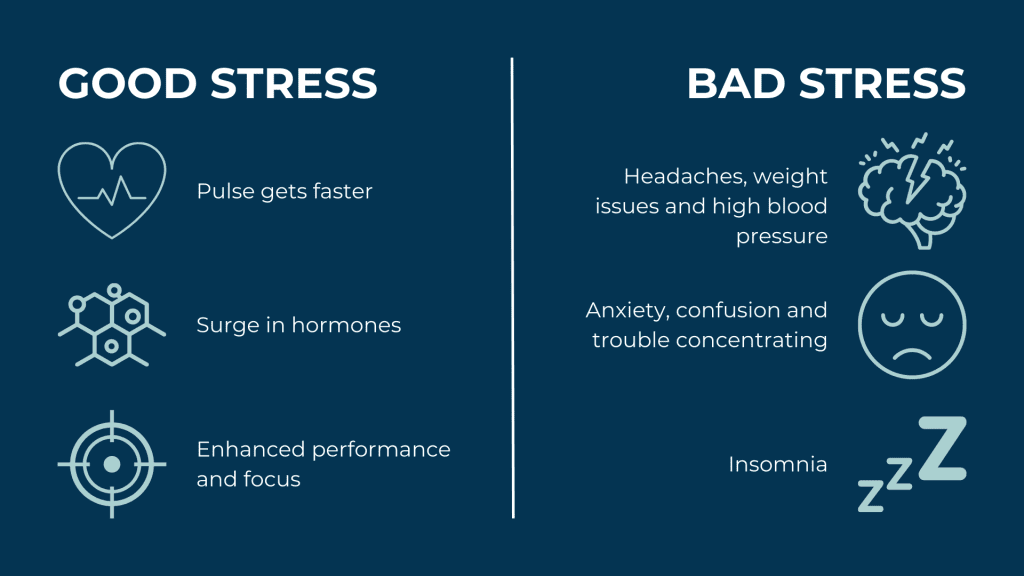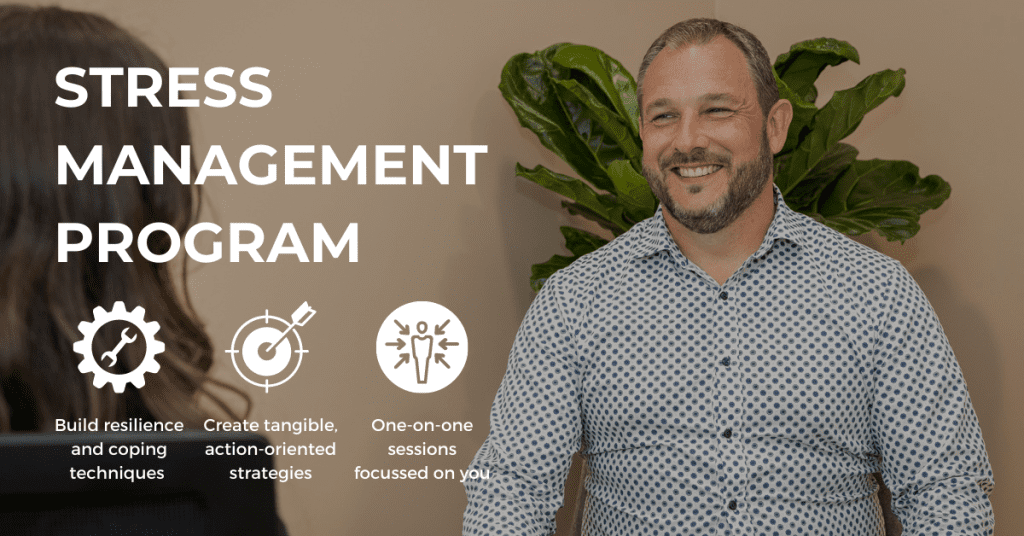
Stress is a common presence in our lives, whether it stems from personal, professional or societal factors. In fact, nearly 50% of Australians see their sleep impacted by stress, with 25% stating that stress is overwhelming their lives (The Banyans Healthcare Group, 2022).
While stress may seem like a solely negative occurrence, it is a force that can be harnessed for good with some careful understanding. For example, when high-performing athletes harness the positive kind of stress, they’re able to build significantly better results in their athletic performances as an outcome of this heightened focus.
In order to learn how to use stress positively, we need to understand what it is, what happens in our body when a stress response occurs and the different types of stress.
What is stress?
Stress is generally described as the feeling of being overwhelmed or unable to cope with mental pressure. It impacts each of us differently, but there are common symptoms that make themselves known. Stress results in physical, emotional and intellectual responses that are designed to help our bodies adjust to new situations.
Stress can be a positive, keeping us alert and prepared in the face of danger. However, stress can become an issue when stressors continue without periods of relief or relaxation. Physical symptoms of stress include:
- Chest pain
- The sensation that your heart is racing
- Exhaustion
- Issues falling asleep or staying asleep
- Headaches and dizziness
- Increased blood pressure
- Aches and pains throughout the body
- Muscle tension
- Clenched jaws
- Digestive issues
- Sexual function issues
- A weakened immune system

Alongside the physical symptoms, stress can result in emotional or physical impacts, including anxiety, depression, panic attacks and sadness.
Chronic stress, a consistent sense of pressure or overwhelm that lasts over a long period of time, can lead to unhealthy behaviours as people look to manage its ongoing negative impacts. These kinds of coping mechanisms can include overindulging in alcohol, gambling, eating disorders, compulsive behaviours, and relying on substances to regulate moods.
However, these consequences of stress are not the only option when we are exposed to stressors.
Related: Stress, sleep and your health
Fight or flight: what happens to our body during a stress response?
Once our body has judged a situation as being stressful, the hypothalamus, which is at the base of the brain, is activated. It sends signals to the pituitary gland and the adrenal medulla. These responses are produced by the ‘fight-or-flight’ response, occurring via the Sympathomedullary Pathway (SAM). When the adrenal medulla, part of the peripheral nervous system, is activated, it secretes adrenaline, the hormone responsible for preparing our bodies for a fight or flight response.
You have most likely felt this before when you’re alerted to a danger – your digestion may change, sweat increases, your heart rate and blood pressure rises. These are all the impact of the presence of adrenaline, triggered by stress. Once the ‘threat’ has passed, the parasympathetic branch takes back control, returning the body to a balanced state.

In our modern lives, this fight-or-flight response is likely to be triggered by emotions such as stress, fear, anxiety, aggression, and anger. Given the wide range of scenarios in which we may experience these emotions, learning how to harness that fight-or-flight response can have positive results.
“Stress is our body’s natural fight or flight response,” says psychologist Peter Hayton. “When we are put in high stakes situations it’s normal to feel a little uneasy. We feel stressed when what is expected of us exceeds our ability to cope – this can be due to factors like our work, school or home environment and even other health conditions.”
The good, the bad and the ugly types of stress
Not all stress is made equal. There’s a major difference between healthy and unhealthy stress, with too much of the unhealthy kind leading to ongoing detrimental impacts across our bodies.
Good stress, or ‘eustress’, is the kind of stress that occurs when you’re excited. Your pulse gets faster, and you feel that surge in your hormones – however, there’s no threat in your environment. This stress is common during life events such as important work meetings, early romantic encounters, waiting for a rollercoaster to start, in the moments before a big competition. This kind of stress is characterised by its short-term nature, a tool that can be used to focus your energy and enhance your performance, while disappearing once the event itself takes place.
Bad stress, or ‘distress’, makes itself known quite differently. This is the kind of stress that can cause harm to your health, contributing to anxiety, confusion, trouble concentrating and an ongoing sense of jitteriness. This kind of negative stress is either acute or chronic, with chronic stress associated with a number of negative health effects. If you’ve ever experienced headaches, insomnia, weight issues, anxiety or high blood pressure as a result of stress, this is the kind of stress that’s contributed to those outcomes.

There are a number of physical, mental and emotional indicators of stress moving from the healthy kind to the unhealthy kind. These include:
- Depression or anxiety related to external stressors
- Constant anger or irritability
- A sense of overwhelm and a lack of motivation
- Trouble falling, or staying, asleep
- Constant concern and racing thoughts
- Ongoing issues with memory and concentration capacities
- Constant headaches
- Teeth grinding or clenching your jaw
- Heaviness in your chest alongside an increased heart rate or chest pain
- Aches and pains in your shoulders, neck or back
Related: Is stress sabotaging your life?
How can you use stress to your advantage?
By monitoring your stress levels and the kind of stress you’re experiencing (healthy or unhealthy), you can use stress as a positive force in your daily life. Stress doesn’t need to be something we feel powerless against. Instead, we can harness its impact, directing it towards outcomes that serve us.
The first key to using stress to your advantage? Developing your self-awareness. By viewing its presence as an indicator of where we need to focus our attention, we can use stress to highlight vulnerabilities or areas where we need to reach for a wider set of tools. This is second-nature to high-performing athletes or individuals within demanding work environments. There, positive stress can highlight potential problems, identify opportunities for growth, and draw attention to the areas where their focus should be razor-sharp.
Consider an orchestra performing together, where deep focus is required on the conductor whilst in the midst of dozens of instruments and other external stimuli – here, this kind of positive stress can increase focus, attention and allow for other stimuli to be ignored if not useful to the task at hand. This is a powerful tool for all of us to harness, allowing stress to become a natural highlighter of areas where we need to mindfully consider our approach to a situation or an opportunity.

Stress can also help us to prioritise. Our natural stress responses can provide clarity as to where our attention must be allocated, and what can fall further down the priority list until those priorities are tackled. The benefits here are two-fold: first, you can prioritise the tasks that are most likely to move the needle amongst a sea of to-do lists; second, you’ll feel a sense of accomplishment once those high-priority tasks are completed, fuelling your ongoing momentum.
One unique opportunity the presence of stress offers us is the chance to invite others into our experience. When stress is rising, this is a point where we have the choice to reach out to others for help, input or to share the load. This can lead to beneficial and meaningful relationships, whether at home or work, and requires a focus on communication around what the stressor is and how it can be tackled together. Stress within a relational environment is an opportunity for connection and empathy, requiring those involved to build better communication strategies. Because one of the ways stress increases is through isolation with the stressor itself, inviting others into our daily experiences is a step in the direction towards using stress for your advantage.
Related: Strategies for stress
Harness the power of stress
Learning about our individual relationship with stress provides us the opportunity to recognise the role it plays in our everyday lives. While bad stress can lead to ongoing health impacts, good stress can help us to identify opportunities for growth, connection, development and engagement. Invest in yourself by learning how good stress and bad stress presents itself in your life, finding the tools you need to minimise its negative impacts and make the most of what stress can highlight to you.
Our Stress Management Program was designed specifically to build resilience and coping techniques to use stress to your advantage. By identifying the root of these stressors, our team works to equip you with tangible, action-oriented strategies and tools to implement in your life. Learn more about our Stress Management Program by clicking the button below.













